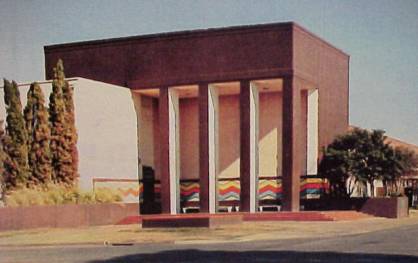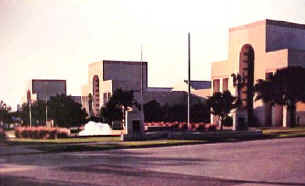Overview Prior to Conservation Treatments
October 31, 1999
Painting Techniques and Materials | Conservation Treatment Proposal
Centennial Building
Described as one of the “finest collections of Art Deco buildings in the country”(1), Fair Park is a product of the 1936 Texas Centennial Celebration. Fair Park represents the epitome of collaborative public art that combined the talents of architects, artists and craftsmen. It is a unique complex of architecture, monumental sculpture and mural paintings. Fair Park has established itself in a long history of other great expositions of the 1930’s still in existence. Its addition to the National Register of Historic Places within the last ten years ranks Fair Park along with the “Alamo” and the “State Capitol” as one of the more significant cultural and historical sites in the State of Texas.
Painted by Carlo Ciampaglia, the massive geometric forms of the murals dominate the walls beneath the porticoes of the Centennial Building and the Food and Fiber Building. They provide a colorful counterpoint to the adjacent terracotta walls of the building, drawing the spectator into its more intimate space. The murals of the Centennial Building depict the State’s history as well as its natural and industrial resources. Stylistically they represent a blend of classical, Art Deco and traditional Texas motifs.
Beginning with the West portico proceeding East toward the Hall of State, the eight murals on the portico walls of the Centennial Buildings are as follows:
- Motion
- Traction
- Railroad Transportation
- Navigation
- Future Transportation
- Old Methods of Transportation
- Aeroplane Transportation
- Automotive Transportation
Three medallions are painted on the exterior wall surfaces beneath the three South facing porticoes (opposite murals Railroad and Navigation, Future and Old Methods of Transportation and Aeroplane and Automotive). Painted by unknown artists, the subjects represent:
- Spain
- Confederacy
- Texas
In addition to the Centennial Building murals, six other murals were painted on the walls of the porticoes of the Automobile Building (originally called the “Varied Industries’ Building”}. Unfortunately the murals were lost when a fire destroyed the Building in 1942. They depicted a number of diversified industries and were entitled: “Electricity”, “X-rays”, “Wildcatter”, “The Inventors”, “Photographic Process”, “Iron Workers”, “Power Dam”, Lens Makers” and “Miners”. Black and white photographs of these murals point out stylistic differences from those on the Centennial Building. Contemporary newspaper articles describe both sets of murals as being painted in “full rich colors that are associated with Italian art….”(2). It may have been at the time of the reconstruction of this building that the murals on the Centennial Building were painted out so that the two buildings would be mirror images.

Food and Fiber building 1999
Other murals included in this project are located on the Food and Fiber Building. They are as follows:
- Fecundity by Carlo Ciampaglia, located at the West Porch of the Food and Fiber Building
- Wheat Harvester by Carlo Ciampaglia, located at the West Porch of the Food and Fiber Building
- Pollination of Nature by Carlo Ciampaglia, located in the lunette at the east end of the building
- Wheat Sheaves with Scythe and Sickle mural by Carlo Ciampaglia, recently discovered, located at east end of building in same porch as Pollination of Nature.
Over the past fifty years, the murals have been concealed by multiple layers of over paint. They were thought to be lost until sandblasting of a section of the Centennial building’s exterior revealed a portion of “Motion”.
Scott M. Haskins, Conservator
Pres. FACL, Inc.

